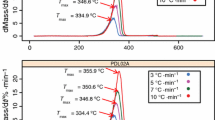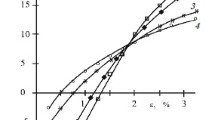Abstract
With regard to lifetime prediction of technical textiles, the correlation of relaxation master curves (RMC) constructed from short-time relaxation measurements performed under variation of (a) elongation and (b) temperature with real-time behavior of PET fibers was studied. The comparison with relaxation measurements covering several days indicated that the actual behavior of the material was better described on the basis of the ‘time–temperature-analogy’. Analyses of hydrolyzed material showed that the reliable construction of the RMC of aged monofils was possible by means of a ‘time–aging parameter-analogy’. The obtained RMC exhibited a congruent shape to the RMC of the new material, but was shifted on the logarithmic time axis. It is concluded that this time-shift relates to the aging acceleration effected by the hydrolyzing procedure. The similarity of the shape of the curves also indicates, that the RMC of the new material gives a satisfactory prediction of the actual aging behavior.














Similar content being viewed by others
References
Hay JN (1995) The physical ageing of amorphous and crystalline polymers. Pure Appl Chem 67:1855–1858
Bahners T, Schloßer U, Schollmeyer E (2003) Zum Effekt von Oberflächenmodifizierungen auf die Alterungsbeständigkeit von Hochleistungsfasern. Technische Textilien 46:78–80
Bahners T, Schollmeyer E (2003) Some thermo-mechanical and aging properties of PBT and PTT fibers. Chem Fibers Intl 53:420–421
Opwis K, Bahners T, Schollmeyer E (2004) Improvement of the alkali-resistance of poly(ethylene terephthalate) fibers by a photochemical modification using excimer-UV-lamps. Chem Fibers Intl 54:116–119
Williams ML, Landel RF, Ferry JD (1955) The temperature dependence of relaxation mechanisms in amorphous polymers and other glass-forming liquids. J Am Chem Soc 77:3701–3707
Kosfeld R, Lohmann W (1980) Eine Meßapparatur zur Untersuchung des Kriech- und Relaxationsverhaltens von Polymeren unter Torsion. Colloid Polym Sci 258:209–218
Barbero EJ, Ford KJ (2004) Equivalent time temperature model for physical ageing and temperature effects on polymer creep and relaxation. ASME J Eng Mat Technol 126:413–419
Zarrelli M, Skordos AA, Partridge IK (2010) Toward a constitutive model for cure-dependent modulus of a high temperature epoxy during the cure. Eur Polym J 46:1705–1712
Brinson LC, Gates TS (2000) Viscoelasticity and aging of polymer matrix composites. In: Kelly A, Zweben C (eds) Comprehensive composite materials: polymer matrix composites, vol 2. Elsevier Science Ltd., Amsterdam
Yu H (1983) Ein Beitrag zur Spannungsrelaxation von Polyesterfasern. Dissertation, RWTH Aachen
Ibar JP (1979) Nonequilibrium tensile deformation of amorphous polymers in the rubbery state: I. Temperature, strain rate, and strain effects. J Macromol Sci Phys 16:355–375
Ibar JP (1979) Nonequilibrium tensile deformation of amorphous polymers in the rubbery state. II. Effect on birefringence and elastic strain energy of temperature, strain rate, and strain. J Macromol Sci Phys 16:551–579
Schulz J, Stalevitsch A, Eickmeier A, Bossmann A, Schollmeyer E (1996) Modell zur Beschreibung der viskoelastischen Eigenschaften von synthetischen Fasern. Angew Makromol Chem 234:159–175
Persoz B (1957) Cahier groupe franc etudes rheol 2:18
Beier M, Schollmeyer E (1989) Mechanische Eigenschaften von Polyesterfasern bei kurzzeitiger Beanspruchung, 3 - Konstruktion von Relaxations- und Retardations-Masterkurvenvon Polyester-Multifilamentgarn. Angew Makromol Chem 169:1–15
Beier M, Schollmeyer E (1989) Mechanische Eigenschaften von Polyesterfasern bei kurzzeitiger Zugbeanspruchung, 1 - Aufbau eines Messplatzes fur schnelle Zugbeanspruchung. Angew Makromol Chem 168:37–52
Bahners T, Schloßer U, Gutmann JS (2012) Characterization of the mechanical properties of technical fibers at extreme strain rates. Makromol Mater Eng 297:550–558
O’Connell PA, McKenna GB (1997) Large deformation response of polycarbonate: time–temperature, time–aging time and time–strain superposition. Polym Eng Sci 37:1485–1495
Carta D, Cao G, D’Angeli C (2003) Chemical recycling of poly(ethylene terephthalate) (PET) by hydrolysis and glycolysis. Environ Sci Pollut Res 10:390–394
Yoshioka T, Grause G (2008) Hydrolysis of polyesters and polycarbonates. In: Moeller HW (ed) Progress in polymer degradation and stability. Nova Science Publishers, New York
Acknowledgments
The research project (IGF no. 16198 N) of the Forschungskuratorium Textil e. V. was funded by the Bundesministerium für Wirtschaft und Technologie within the program Industrielle Gemeinschaftsforschung (IGF) by the Arbeitsgemeinschaft industrieller Forschungsvereinigungen e. V. (AiF).
Author information
Authors and Affiliations
Corresponding author
Rights and permissions
About this article
Cite this article
Bahners, T., Schmidt, M. & Gutmann, J.S. Correlation of material lifetime predictions by artificial aging vs. the relaxation master curve. Polym. Bull. 70, 1659–1676 (2013). https://doi.org/10.1007/s00289-013-0951-y
Received:
Revised:
Accepted:
Published:
Issue Date:
DOI: https://doi.org/10.1007/s00289-013-0951-y




